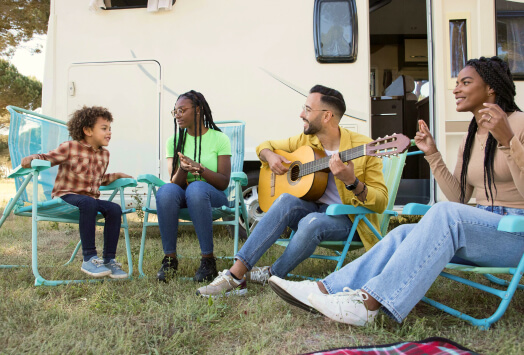While there are lots of great outdoor winter activities for kids, spring, summer, and fall make for much better times to encourage your child to get outside. But, why is it important for children to play outdoors? What benefits do they gain from spending time outside? And, how can you support and encourage your child to spend more time outdoors?
As an early childhood learning specialist, I get these questions a lot from families. In this article, I will outline the benefits of outdoor play as well as some great tips to help you encourage and support your child’s outdoor experiences so that they grow to love being outside.
Benefits of outdoor play
Gross motor and sensory motor development
Children who play outside have more opportunities to move in ways that strengthen their muscles, endurance, agility, balance, and sensory processing systems. Running, climbing, walking barefoot in the grass, playing in the sand, walking and balancing along fences, running in the rain, etc are all examples of these opportunities.
Science learning
When children play outdoors, they have so many more chances to observe science in action. They learn about cause and effect, trial and error, and more by discovering what is going on around them.
Community ecology
Exploring the natural world that exists right outside a child’s front door deepens their sense of place. To have a foundational understanding of the ecology of one’s own neighborhood or park, which birds nest where, which plants are helpful to the local animal life, how the same tree looks different through the seasons, gives children deeper roots from which to grow and make sense of the broader world.
David Sobel, the American educator who is responsible for developing the philosophy of “place-based education” said, “Encourage your child to have muddy, grassy, or sandy feet by the end of each day, that’s the childhood they deserve.” Even if they are just across the street at the playground, let them learn their local environment in the most hands-on way possible.

Opportunities for problem solving and risk taking
Spending time outside gives children chances to solve problems and take risks. Maybe they want to work on balancing sticks to build a lean-to structure or climb a big hill to see the view. Whatever they are doing, children need to problem solve and develop their ability to persevere through challenges when playing outdoors.
Social emotional development and interaction
Outdoor play is a natural setting for social interaction and social emotional development. For example, when two children take turns on a rope swing, they learn to be patient for their turn and give up the swing to the other when it’s time. They strengthen and develop their empathy when they encourage friends and peers to try something that might make them nervous, like climbing a tree.
Healthy living and less screen time
Children who build a love of playing outdoors gain healthy habits that continue to benefit them throughout their lives. They spend less time on their screens and more time enjoying nature, which is important for them as they get older. Plus, playing outside in the sun gives children more Vitamin D, which is important to their growth and development.
Better night’s sleep
One of the best benefits of outdoor play for children and the adults in their lives is that they get a better night’s sleep after romping around outdoors. The combination of sunshine, exercise, and sensory-motor exploration will often tire a child so they sleep soundly.
How to encourage outdoor play
Now that you know some of the many benefits of outdoor play, you are probably thinking to yourself, how can I encourage my child to play outside? Not every child will immediately take to spending time outside of their bubble. However, it is valuable for children of all ages to develop an appreciation for the outside world and genuinely want to spend time outdoors. Here are some ways to encourage outdoor play for your child.
Make supplies readily available
Place a basket by the door with bubbles, a kite, chalk, a bucket for collecting outdoor treasures, rubber bands and twine in a Ziploc bag, craft materials such as watercolors to paint the sidewalk, road, rocks, or leaves. You can even include binoculars for bird watching and a child’s bird watching book if you think that will interest them. Just make these play materials visible and easy to grab to get your child excited about going outside.
Start or join a garden
Borrow or buy some gardening tools. Even if you don’t have a garden you can put together a window box outside or find a community garden to join. There are so many benefits of gardening with kids and getting outside is just one of them! Children also get to practice responsibility and self sufficiency while learning healthy eating habits.

Head for the hills
Go slightly further afoot for some adventure. Try hiking, skiing, rock climbing, kayaking, cave exploring…they will likely all be a hit! Children (and adults!) crave adventure, so take the time to show your child that it is not too far away.
Turn to books
Hit the library or bookshop and grab some books that focus on outdoor wonders. These can entice your child’s nature-based imagination and sense of adventure. Check out Run Wild, Caterpillar and Bean, and Worm Weather, fun spring books for toddler and preschool aged children
Take a trip down memory lane
Look through old photos and videos of previous outdoor fun to remind your children how much they loved getting outside and playing in years passed. Sometimes the cold and dreary winter months make them forget, so this is a great way to get them excited about going outside again!
Personalize the outdoor experience
Think about what your child loves most and bring that passion outside. Are they really into theater and dressing up? Then, bring some play silks or scarves to an outdoor theater space in the park. Have a little architect on your hands? Brainstorm what materials you might bring outside to build a fort. Got a science enthusiast? Bring a bug box and magnifying glass to the woods. The next Monet? Collect elements from outside and create nature crafts.
Try to get outside at unusual times
A night walk with flashlights or a special sunrise scooter or bike ride can be nice bonding times with a parent as well as an opportunity to make going outside feel extra special. They may see things they wouldn’t normally see and the world feels different in the dark.

With the above tips and suggestions, you will likely see your child’s passion for the outdoors grow. Then, you can reap the benefits by seeing your child grow socially and physically, spend less time on screens, and sleep better at night.
If you are looking for in-person, outdoor activities, check out what the educators on Sawyer have to offer. From team sports to STEM education, once the weather is warm, everything can be done outdoors. Happy spring to you and your family!

















